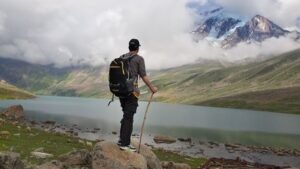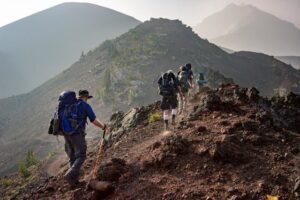Ever wondered about the world’s last great wilderness? Svalbard, a remote Norwegian archipelago, awaits. It’s deep within the Arctic Circle and offers an unforgettable high Arctic journey. This frozen wonderland boasts majestic glaciers, dramatic fjords, and abundant wildlife. It’s a dream for both adventurers and nature lovers.
But what makes polar adventures here so special? And how can you truly experience the essence of this remote Arctic gem?
Table of Contents
ToggleIntroduction to the Norwegian Archipelago
The Norwegian archipelago of Svalbard sits between the mainland and North Pole. It’s over 600 miles from the North Pole. Svalbard promises an adventure into the wild heart of the Arctic. This area is known for its tough, Arctic climate, long winters, and short summers. It’s home to glaciers covering 60% of the land and stunning fjords.
The Svalbard region shows us the awesome power and beauty of the Arctic.
Geographical Location and Climate
Svalbard lies in the Norwegian Arctic, between mainland Norway and the North Pole. This area has a cold, Arctic climate with long winters and short summers. Temperatures range from -4°F (-20°C) in winter to 45°F (7°C) in summer.
History and Significance of Svalbard
Svalbard’s history dates back to the 16th century. It became a key spot for Arctic exploration, whaling, trapping, and scientific research. Today, it’s a unique land, governed by the Svalbard Treaty. This treaty emphasizes sustainable tourism and protecting the environment.
Planning Your Arctic Adventure
Heading to the Arctic, especially Svalbard, needs lots of planning. It’s key to pick the right time to go. June and July are perfect with mild weather and lots of light. These months let you enjoy hiking, watching wildlife, and exploring the islands.
Best Time to Visit Svalbard
Svalbard is great to visit all year, with each season offering different wonders. Spring and fall are less crowded and perfect for seeing the Northern Lights. But, any time you visit, be ready. The Arctic’s always challenging, needing special gear and the right mindset.
Essential Preparations and Packing Tips
Preparing well is vital for a safe and fun trip in the Arctic. Know the rules, get permits, sort out travel, and pack right. The right clothes and gear, like layers, waterproof stuff, and solid boots, will keep you cozy and make your trip unforgettable.
| Best Time to Visit Svalbard | Essential Preparations | Packing Tips |
|---|---|---|
|
|
|
Glaciers and Fjords of Svalbard
The beautiful area of Svalbard is full of glaciers and stunning fjords. They make up most of the land here. These icy glaciers show the tough, cold weather in the Arctic. They also show us the great power of nature.
The glaciers have shaped amazing fjords. These long, twisting waterways cut through the cold, rocky land. They form a natural wonder that captures everyone’s attention. From the high cliffs created by the ice to the calm waters of the fjords, nature’s beauty is everywhere.
People who love adventures can hike, kayak, or take a boat in these places. This lets them get close to Svalbard’s icy world. They can see the bright blue ice up close. They can even watch as big parts of the ice break off, making huge icebergs. A trip to Svalbard’s glaciers and fjords is something they’ll always remember.
Witnessing the Mesmerizing Northern Lights
One of the most captivating natural phenomena that draws visitors to Svalbard is the mesmerizing display of the northern lights, or aurora borealis. This light show is created by the Earth’s magnetic field and charged particles from the sun. It results in a colorful dance across the sky at night.
Understanding the Aurora Borealis
The aurora borealis is a stunning light show seen in the Earth’s atmosphere. It’s mostly seen in high-latitude areas near the Arctic and Antarctic circles. When solar wind hits the Earth’s magnetic field, the air glows in colors like green, purple, blue, and red.
Best Locations for Northern Lights Viewing
Svalbard is one of the top places for northern lights viewing. Its location and low light pollution are perfect. This allows visitors a great chance to see the aurora borealis during the long, dark winters.
| Best Locations for Northern Lights Viewing | Highlights |
|---|---|
| Svalbard, Norway | High-latitude location, minimal light pollution, optimal viewing conditions during the long, dark winters |
| Rovaniemi, Finland | Located within the Arctic Circle, clear skies and frequent northern lights sightings |
| Fairbanks, Alaska | Situated in the “aurora oval,” one of the best places in the world for northern lights viewing |
| Yellowknife, Canada | Excellent northern lights viewing opportunities due to its northern latitude and clear skies |
Svalbard: Exploring the High Arctic
Svalbard invites you to a true Arctic adventure. You can explore the archipelago by boat, hike its rugged paths, or join a guided tour. The exploration of Svalbard ensures an immersive, unforgettable journey.
For those into Arctic expeditions, Svalbard is a must-visit. It’s a place where you find breath-taking natural sights like big glaciers and stunning fjords. You’ll dive into a wild adventure at this remote spot, feeling the raw power of the high Arctic first-hand.
Exploring Svalbard is unique by any means. You might sail through the archipelago, start a hiking journey, or opt for a tour. Each way, you’ll encounter changing Arctic sceneries and a rich wildlife. These adventures make you closely connect with one of nature’s last untouched areas.
Encountering the Majestic Polar Bears
Svalbard is a top destination for those eager to see the iconic polar bear. These powerful predators freely move in the archipelago’s cold, snowy world. For many explorers, spotting a polar bear is not just thrilling; it’s a glimpse into the Arctic’s unique life.
Responsible Wildlife Viewing
Watching polar bears in their natural home must be done responsibly. Keep a safe distance and don’t disturb them. Always listen to experienced guides. This way, you can enjoy seeing wildlife without harming their environment.
Polar Bear Conservation Efforts
Protecting polar bears should be a top concern. The changing Arctic poses many challenges to their survival. Svalbard hosts groups focused on helping these bears thrive.
Visitors can help by joining educational activities, giving to conservation groups, and raising awareness.
| Polar Bear Facts | Key Statistics |
|---|---|
| Average Weight | 350-600 kg (770-1,320 lbs) |
| Lifespan | 15-30 years in the wild |
| Population | Approximately 26,000 worldwide |
| Conservation Status | Vulnerable on the IUCN Red List |
Sustainable Tourism in the Arctic Region
Svalbard, a remote place, is very sensitive to the environment. It focuses on sustainable tourism to keep the Arctic safe. The area wants visitors to be mindful and protect the ecosystem. They should lower their carbon footprint and help the local people.
Minimizing Your Carbon Footprint
To visit the Arctic, you need to care about the environment. You can make a difference by picking greener transport, like electric cars. Staying in accommodations and joining tours that care about the planet is a good start.
Supporting Local Communities
Getting involved with the Svalbard community helps in their sustainable tourism mission. You can do this by buying from local shops, taking part in community projects, and learning about their ways.
This approach helps preserve the Arctic’s beauty for the future. It’s all about traveling responsibly and valuing the stunning but fragile natural world.
Wilderness Expeditions and Remote Explorations
Svalbard is perfect for adventurers. You can go on exciting wilderness expeditions far into the high Arctic. You’ll be in the heart of the archipelago’s rugged, unspoiled beauty, far away from civilization.
Hiking and Trekking Opportunities
The rough, untouched landscape of Svalbard is a haven for hikers and trekkers. You can traverse glacial lands or climb mountain ridges. These adventures let you find the archipelago’s secrets and see its natural beauty up close. There are tours for all levels, so everyone can enjoy an amazing trip.
Kayaking and Boat Tours
For a calmer experience, try kayaking or taking a boat tour in Svalbard’s fjords. As you silently glide on icy waters, you might see seals, walruses, and polar bears. This unique trip lets you get close to the Arctic’s wonders in a personal, unforgettable way.







